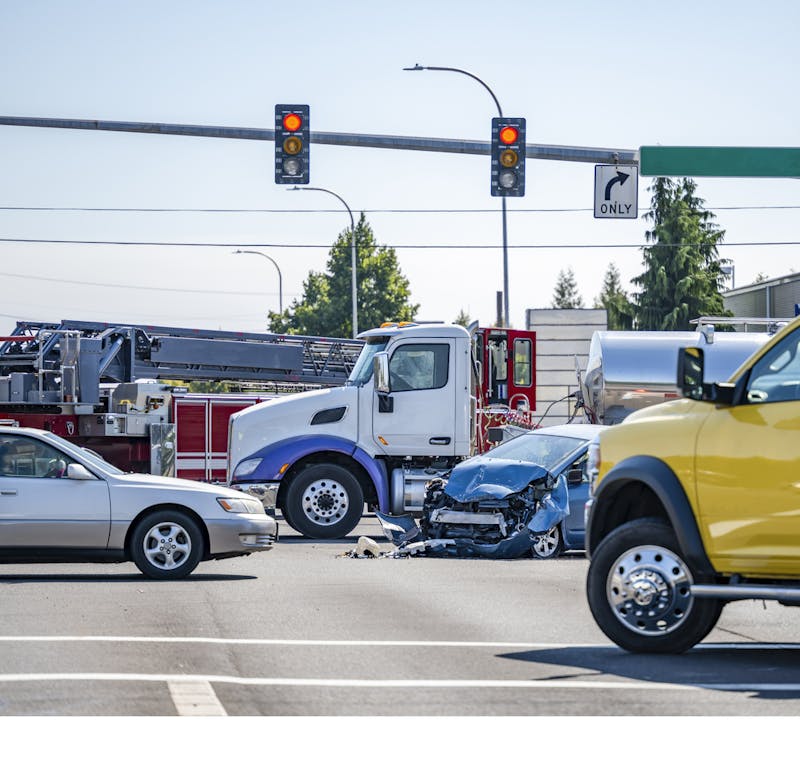Accidents involving 18-wheelers are often catastrophic, not just because of the size and weight of the vehicle, but because of the complex liability and severe injuries that follow.
These crashes aren't rare, either. In fact, large trucks were involved in over 523,000 crashes in the United States in 2021, with over 117,000 causing injuries and nearly 5,100 resulting in fatalities, according to the Federal Motor Carrier Safety Administration (FMCSA).
At Webster Vicknair MacLeod, we have decades of experience representing victims of serious truck accidents nationwide. Below, we break down the most common types of 18-wheeler accidents, so you can better understand the risks and how we fight back when tragedy strikes.
1. Jackknife Accidents
- A jackknife occurs when the truck’s trailer swings outward and forms an angle with the cab, often resembling a folding knife
- This typically happens when the driver brakes suddenly or skids on slick roads
- Jackknife accidents can block multiple lanes of traffic and lead to chain-reaction collisions
- Poor road conditions, speeding, and inexperience are common contributors
- These incidents are particularly dangerous on highways, where surrounding vehicles have little time to react
2. Rollover Accidents
- Due to their high center of gravity, 18-wheelers are vulnerable to rollover accidents, especially during sharp turns or when improperly loaded
- According to National Highway Traffic Safety Administration (NHTSA) data, nearly 18% of fatal large truck crashes involve rollovers, far more than the 3% rollover rate seen in passenger vehicles
- These accidents can crush smaller cars, create fuel hazards, and lead to multi-vehicle pileups
3. Underride Accidents
- Underride accidents are among the most deadly
- They occur when a smaller vehicle slides underneath the trailer of a truck, often during a sudden stop or rear-end crash
- In many cases, the roof of the smaller car is sheared off, resulting in catastrophic or fatal injuries
- Despite their danger, not all trucks are equipped with effective underride guards
- The Government Accountability Office (GAO) has called for stronger enforcement of regulations requiring rear and side underride protection
4. Rear-End Collisions
- Due to their size and stopping distance, 18-wheelers need 40% more distance to come to a complete stop compared to passenger vehicles, according to the Insurance Institute for Highway Safety (IIHS)
- When a truck follows too closely or a driver is distracted or fatigued, devastating rear-end crashes can occur
- These collisions are especially harmful when the truck strikes a smaller car from behind, often forcing it into other vehicles or off the road entirely
5. Blind Spot (No-Zone) Accidents
- Large commercial trucks have significantly larger blind spots—often referred to as “no-zones”
- These blind spots exist on all four sides of the vehicle and can extend up to 20 feet in front and 30 feet behind the trailer, per FMCSA guidelines
- If a truck driver changes lanes without checking these no-zones, it can lead to a serious side-swipe or run-off-road crash, endangering smaller vehicles that are nearly invisible from the cab
6. Tire Blowouts
- When a tire blows out on an 18-wheeler, the sudden imbalance and force can send the truck veering into adjacent lanes—or off the road entirely
- Blowouts are often caused by poor maintenance, overloading, or defective tires, and they create significant hazards from both the loss of vehicle control and debris scattering across roadways
- The FMCSA requires routine tire inspections and proper inflation, but violations remain common, putting others at risk
7. Lost Load or Cargo Spill Accidents
- Improperly secured or overloaded cargo can shift, spill, or detach entirely during transit
- This is not only dangerous for nearby vehicles but can also cause secondary crashes as drivers swerve to avoid debris or overturned freight
- Hazardous materials—like fuel or chemicals—can escalate the danger and require specialized cleanup crews
- Responsibility may lie with the loading company, the trucking firm, or both
Pursuing Accountability in the Aftermath
Every type of 18-wheeler accident shares one thing: the potential for life-altering consequences. But proving liability isn’t always straightforward. Truck drivers, transportation companies, third-party maintenance providers, and manufacturers may all be at fault, and each will have legal teams working to minimize their responsibility.
That’s why victims turn to Webster Vicknair MacLeod. With over 120 years of combined experience and a record of multi-million-dollar results, we uncover every angle, identify every liable party, and fight to hold them accountable. Contact us today to book your consultation and learn more.
